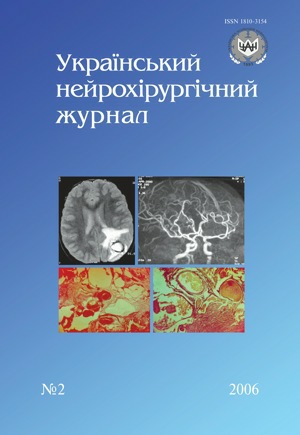Chiari malformation at adults surgical treatment results
DOI:
https://doi.org/10.25305/unj.126815Keywords:
Chiari anomaly, surgical treatmentAbstract
The results of 93 patients, operated in 1995–2005 yrs with various kinds of Chiari malformation supervision and surgical treatment were analyzed. For the period of investigation three different variants of surgical tactics depending on type of Chiari malformation were consistently applied. Surgical tactics change have been caused by search of clinical results improvement ways and unsatisfactory results on control MRI researches in case of first and second surgical tactics variants application.
After operation and in the remote period the neurological semiology has been in appreciated in details.
For best results achievement the surgical treatment should be directed on suboccipital decompression, restoration of cerebrospinal fluid outflow at craniovertebral junction, posterior fossa or/and craniovertebral junction total volume increase.
References
Alzate J.C., Kothbauer K.F., Jallo G.I., Epstein F.J. Treatment of Chiari type I malformation in patients with and without syringomyelia: a consecutive series of 66 cases // Neurosurg. Focus. — 2001. — V.1, N11. — Art.3.
Badie B., Mendoza D., Batzdorf U. Posterior fossa volume and response to suboccipital decompression in patients with Chiari I malformation // Neurosurgery. — 1995. — V.37. — P.214–218
Batzdorf U. Chiari I malformation with syringomyelia. Evaluation of surgical therapy by magnetic resonance imaging // J. Neurosurg. — 1988. — V.68. — P.726–730.
Bindal A.K., Dunsker S.B., Tew J.M. Jr. Chiari I malformation: classification and management // Neurosurgery. —1995. — V.37. — P.1069–1074.
Chiari H. Uber Verдnderungen des Kleinhirns infolge von Hydrocephalie des Grosshirns // Dtsch Med. Wschr. — 1891. — Bd.17. — S.1172–1175.
Gardner W.J. Hydrodynamic mechanism of syringomyelia: its relationship to myelocele // J. Neurol. Neurosurg. Psychiat. — 1965. — V.28. — P.247–259.
Hida K., Iwasaki Y., Koyanagi I. et al. Surgical indication and results of foramen magnum decompression versus syringosubarachnoid shunting for syringomyelia associated with Chiari I malformation // Neurosurgery. — 1995. — V.37. — P.673–678.
Holly L.T., Batzdorf U. Management of cerebellar ptosis following craniovertebral decompression for Chiari I malformation // J. Neurosurg. — 2001. — V.94. — P.21–26.
Iskandar B.J., Hedlund G.L., Grabb P.A. The resolution of syringohydromyelia without hindbrain herniation after posterior fossa decompression // J. Neurosurg. — 1998. — V.89. — P.212–216.
Iskandar B.J., Quigley M., Haughton V.M. Foramen magnum cerebrospinal fluid flow characteristics in children with Chiari I malformation before and after craniocervical decompression // J. Neurosurg. — 2004. — V.101. — P.169–178.
Kyoshima K., Kuroyanagi T., Oya F. et al. Syringomyelia without hindbrain herniation: tight cisterna magna. Report of four cases and a review of the literature // J. Neurosurg. — 2002. — V.96. — P.239–249.
Lichtor T., Egofske P., Alperin N. Noncommunicating cysts and cerebrospinal fluid flow dynamics in a patient with a Chiari I malformation and syringomyelia. — Part I // Spine. — 2005. — V.30 — P.1335–1340.
Lichtor T., Egofske P., Alperin N. Noncommunicating cysts and cerebrospinal fluid flow dynamics in a patient with a Chiari I malformation and syringomyelia. — Part II // Spine. — 2005. — V.30 — P.1466–1472.
Limonadi F.M., Selden N.R. Dura-splitting decompression of the craniocervical junction: reduced operative time, hospital stay, and cost with equivalent early outcome // J. Neurosurg. —2004. — V.101. — P.184–188.
McLone D.G., Knepper P.A. The cause of Chiari II malformation: a unified theory // Pediatr. Neurosci. — 1989. — V.15. — P.1–12.
Milhorat T.H., Johnson R.W., Milhorat R.H. et al. Clinicopathological correlations in syringomyelia using axial magnetic resonance imaging // Neurosurgery. — 1995. — V.37. — P.206–213.
Mueller D., Oro J.J. Prospective analysis of self-perceived quality of life before and after posterior fossa decompression in 112 patients with Chiari malformation with or without syringomyelia // Neurosurg. Focus. — 2005. — V.18. — ECP2.
Pillay P.K., Awad I.A., Hahn J.F. Gardner's hydrodynamic theory of syringomyelia revisited // Cleve Clin. J. Med. — 1992. — V.59. — P.373–380.
Sener R.N. Cerebellar agenesis versus vanishing cerebellum in Chiari II malformation // Comput. Med. Imag. Graph. — 1996. — V.19. — P.491–494.
Stevenson K.L. Chiari Type II malformation: past, present, and future // Neurosurg. Focus. — 2004. — V.16. — E5.
Tubbs R.S., Elton S., Grabb P. Analysis of the posterior fossa in children with the Chiari 0 malformation // Neurosurgery. — 2001. — V.48. — P.1050–1055.
Tubbs R.S., Iskandar B.J., Bartolucci A.A., Oakes W.J. A critical analysis of the Chiari 1.5 malformation // J. Neurosurg. (Pediatr. 2). — 2004. — V.101. — P.179–183.
Downloads
How to Cite
Issue
Section
License
Copyright (c) 2006 E. I. Slynko, V. V. Verbov, A. I. Pastushin, A. I. Ermolyev

This work is licensed under a Creative Commons Attribution 4.0 International License.
Ukrainian Neurosurgical Journal abides by the CREATIVE COMMONS copyright rights and permissions for open access journals.
Authors, who are published in this Journal, agree to the following conditions:
1. The authors reserve the right to authorship of the work and pass the first publication right of this work to the Journal under the terms of Creative Commons Attribution License, which allows others to freely distribute the published research with the obligatory reference to the authors of the original work and the first publication of the work in this Journal.
2. The authors have the right to conclude separate supplement agreements that relate to non-exclusive work distribution in the form of which it has been published by the Journal (for example, to upload the work to the online storage of the Journal or publish it as part of a monograph), provided that the reference to the first publication of the work in this Journal is included.









